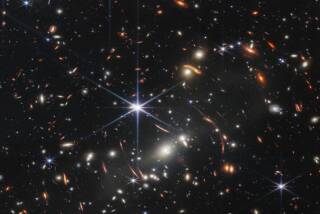Soviet Mission to Photograph Comet Called ‘a Triumph’
- Share via
A Soviet spacecraft has sent back hundreds of photographs of Halley’s comet in a mission that the father of modern cometary science called “truly a triumph.”
“It’s the first time in history we have had this sort of imaging system this close to a comet,” Fred Whipple of the Smithsonian Astrophysical Observatory in Cambridge, Mass., told reporters at the Institute for Space Research in Moscow.
“It is a triumph; it is truly a triumph,” said Whipple, who theorized 35 years ago that comets were “dirty snowballs.”
The moment of encounter, witnessed live by thousands of Americans who tuned in to ABC’s “Nightline” on Wednesday, was marked repeatedly by applause among the scientists who had gathered in Moscow for the historic occasion.
All 15 scientific instruments aboard Vega 1 worked perfectly as the small spacecraft passed within about 5,200 miles of Halley late Wednesday night, suggesting that subsequent probes scheduled to pass even closer may also survive the plunge through the dusty, gaseous cloud that surrounds the comet.
On Thursday, a European Space Agency probe, Giotto, was to pass 10 times closer than Vega 1 got to Halley, coming within about 300 miles of whatever lies at the center of the comet.
That “whatever” is still a matter of conjecture among scientists who are studying the pictures from Vega 1.
“I’m anxious to see the processed images when they’ve had a little time to work with them,” said Steve Edberg, an astronomer with the Jet Propulsion Laboratory in Pasadena and an official of the International Halley Watch. “Clearly, we were seeing structure, but it’s going to take time to analyze it.”
Edberg said the dark “structure” that appears near the center of the photos could be the comet’s nucleus, but it could also include gas jets from the nucleus.
The images sent back by Vega 1 are not photographs in the common sense of the word, but rather “photometric contours” caused by varying intensities of light reflected by the comet. The camera uses filters to present “false color” images, with different colors representing various light intensities, thus permitting scientists to determine specific materials and structures on the basis of their luminosity.
The colors represent “lines of equal brightness,” said Ray Newburn, head of the International Halley Watch. Dust, for instance, reflects more light than gas and would thus be represented as a different color in a false color image.
Orange Object at Center
The photos from Vega 1 show a dark orange object in the center, which some scientists in Moscow believe to be the comet’s nucleus--something no one has ever seen before. If so, Halley’s nucleus is only about 2 to 2 1/2 miles in diameter, about half the size that scientists had expected.
The crude photographs, which will be enhanced in the days ahead, also suggest that the nucleus may be in two pieces, although experts doubt that enhanced photos will support that conclusion.
“I’d be very surprised (if that turned out to be true),” Newburn said. “But we’ve never seen the nucleus of a comet before.”
The photographs, while exciting to astronomers, will probably prove less than spectacular to the general public.
“I knew when I saw them that people were going to be disappointed,” Newburn said.
Matter at Its Most Pristine
Other instruments aboard Vega counted and analyzed dust particles, studied the comet’s magnetic field, measured temperatures and examined nearly every aspect of the comet. Comets are of great importance to scientists because they represent matter in its most pristine form.
“Our instruments have touched for the first time on matter from the beginning of the solar system,” U.S. scientist John Simpson, who designed the only American instrument on Vega, told reporters in Moscow.
The second Soviet probe, Vega 2, is to pass a little closer to Halley on Sunday.
More to Read
Sign up for Essential California
The most important California stories and recommendations in your inbox every morning.
You may occasionally receive promotional content from the Los Angeles Times.










